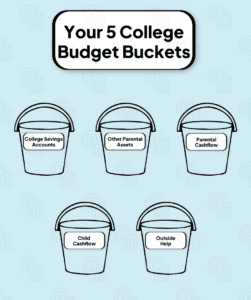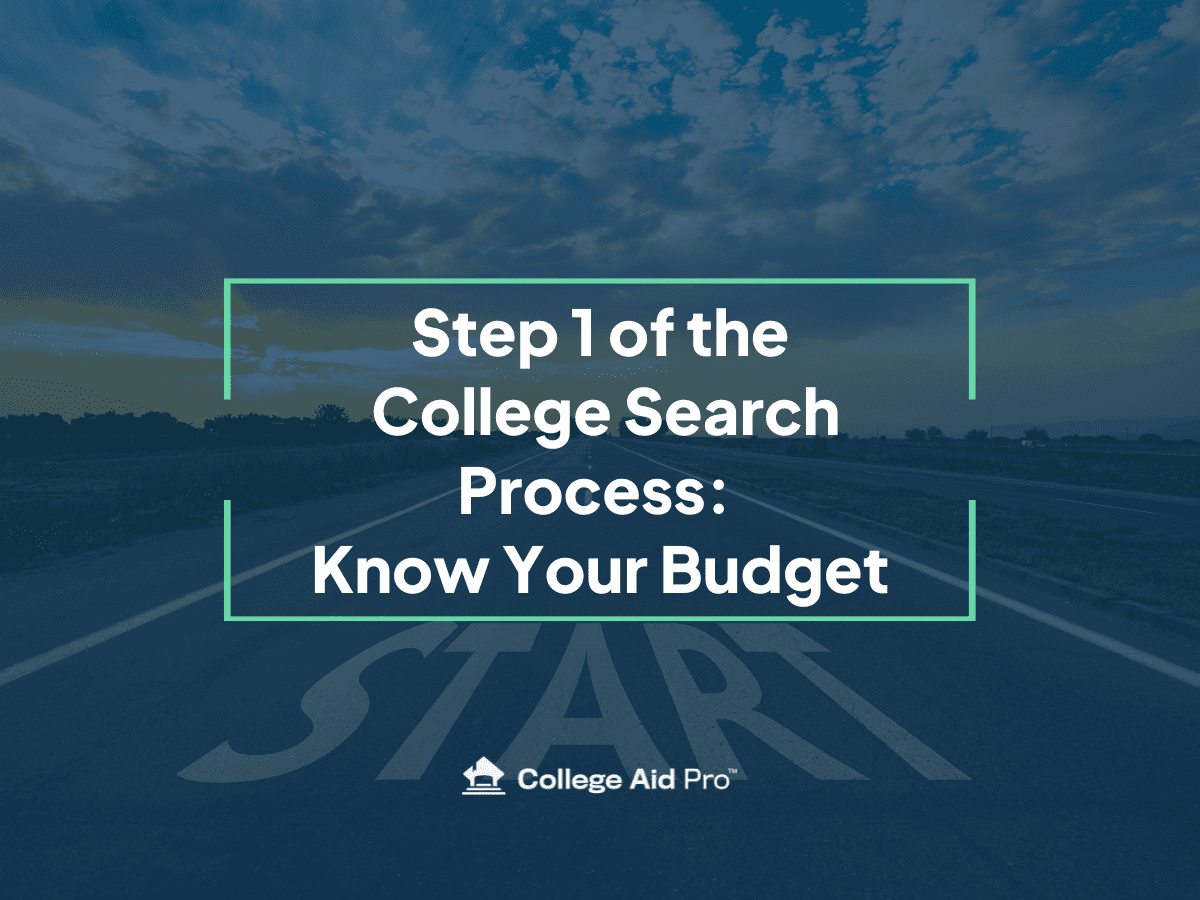The First Step in Your College Search:Creating Your College Budget
Hey Friend, Let’s Talk About College Budgets
I know, I know—talking about budgets isn’t exactly thrilling. But if you’re here, you’re probably starting to think about how to help your high schooler navigate the college process. And I promise you this: figuring out your college budget is the single most important first step.
Here’s the thing: so many families delay the financial conversation. They don’t want to limit their teen, who’s worked so hard and has big dreams. But we see and hear from thousands of families every year who told their kid to “apply wherever, and we’ll figure it out.” Then they’re blindsided by how high the costs really are for their family. Suddenly, they’re staring down tens of thousands of dollars in loans for each year of college or frantically searching for outside scholarships their teen must win to make it work. It’s stressful, unrealistic, and unfair to everyone—and the good news is, it’s completely avoidable.
The truth is, colleges are experts at marketing to your emotions—your love for your child, their dreams, and your desire to see them succeed. They want you to fall in love with the idea of their school, not focus on the price tag. But here’s the reality: if you don’t define your financial boundaries first, you risk falling in love with a school that simply isn’t a financial fit.
That’s why starting with your budget is so important. Think about it: would you ever go house hunting without knowing your mortgage budget? Or shop for a car without knowing how much you’re comfortable spending? Probably not. College is no different—it’s one of the most expensive things you’ll pay for.
The best part? With a little work now, you’ll save yourself (and your teen) so much stress down the road. Let’s break this down step by step.
Step 1: Understand What a College Budget Really Is
Your college budget isn’t just about covering tuition—it’s about planning for the total annual cost of attendance. This includes everything your student will need to live and learn during their college years.
Cost of attendance encompasses tuition, room and board (which, fun fact, can sometimes cost more than tuition itself!), books, transportation, and personal expenses. These aren’t just numbers on a school’s website—they’re the reality of what it takes to make college work for your family.
Want a deeper dive into how these costs break down? Click here to learn more.
The bottom line: a college budget is your financial game plan for everything your student needs to succeed. And when you take the time to create it now, you’re building the foundation for a smoother, less stressful journey ahead.

Step 2: Break Your Budget Into 5 Buckets
Breaking your budget into buckets makes this process less overwhelming and gives you a clear view of where your money is coming from. Here are the five buckets and how to think about each one:
Bucket 1: College Savings Accounts (Assets)
Start with savings that have been specifically set aside for college:
- 529 Plans: These tax-advantaged accounts are designed for education costs.
- Coverdell Education Savings Accounts: Another option with specific contribution limits.
- Prepaid Tuition Plans: If you’ve locked in tuition rates for specific schools.
- UGMA/UTMA Accounts: Uniform Gifts to Minors Act or Uniform Transfers to Minors Act accounts are custodial accounts that may also be part of your college savings strategy.
💡 Pro Tip: If you’re saving for multiple children in one account, divide those shared accounts (like 529s) appropriately. Only include the portion earmarked for this student in your budget.
Bucket 2: Other Parental Assets
This includes money you’ve set aside for college, even if it’s not in a dedicated college savings account:
- Brokerage accounts or stock options.
- Savings accounts.
- Other investments.
💡 Pro Tip: These assets might not have the same tax benefits as 529s, so be strategic about when and how you use them.
Bucket 3: Parental Cashflow
Think of this as your “pay-as-you-go” plan. How much can you contribute from your income each month while your child is in school?
Start by identifying expenses that will go away when your student leaves home—like extracurricular activities, club sports fees, or private school tuition—and reallocate those funds toward college.
💡 Pro Tip: Multiply your monthly contribution by 48 months to calculate what you can realistically contribute over four years.
Bucket 4: Child Cashflow
If your teen is contributing financially to their own education, include those resources here:
- Savings from summer jobs.
- Earnings from part-time jobs during college.
- Other personal contributions.
💡 Pro Tip: Having some “skin in the game” can help your teen value their education even more.
Bucket 5: Outside Help
This bucket includes contributions from family members or other supporters who want to help cover your student’s college costs. It’s important to note that these are not scholarships but personal contributions, typically given as gifts or through informal agreements.
Here’s what to consider:
- Grandparents: Many grandparents set aside money specifically for education, often in a 529 account or other savings vehicle.
- Other Relatives or Friends: Aunts, uncles, or close family friends may also want to help with tuition, room and board, or other expenses.
- Community or Religious Organizations: Some local organizations offer financial support to families in their community, such as church members or long-time participants in local programs. While this isn’t common, it’s worth considering if your family has a strong connection to a group that might be willing to help.
💡 Pro Tip: If you’re eligible for need-based aid, be mindful of when and how outside contributions are used. These funds can sometimes impact financial aid eligibility in future years.

Step 3: Enter Your Numbers Into MyCAP
Once you’ve gathered your numbers, it’s time to put them to work. That’s where MyCAP comes in.
MyCAP is a powerful tool that simplifies the college planning process by helping you:
- Analyze Costs: Input your budget and see what each school on your list will actually cost your family.
- Compare Colleges: View schools side-by-side to see how they stack up in terms of affordability, financial aid, and scholarships.
- Estimate Loan Costs: Understand what you might be borrowing and explore repayment plans, so there are no surprises later.
How It Works
- Complete Your Profile:
- To get accurate results, make sure you fill out your profile completely. This means not only entering the numbers from your college budget but also providing your personal information, including your student’s academic details and your parent financial information.
- The more complete your profile, the more precise your results will be.
- Explore Your Options: Use the MyCAP dashboard to:
- See how your budget aligns with different colleges.
- Get a breakdown of potential costs, including estimated financial aid and scholarships.
- Compare schools side-by-side to find the best financial and academic fit.
- Make Informed Decisions: Play with the numbers, adjust scenarios, and find the schools that work best for your family.
Create your FREE account right now and get started.
💡 Pro Tip: Completing your profile fully ensures that MyCAP can calculate accurate costs and provide tailored insights. This clarity is key to understanding your options and planning confidently.
Why This Matters
Doing this “unfun” work now—before you start diving into the exciting parts of college planning—saves you heartache later. It ensures that you approach the college search with realistic expectations and financial clarity.
This isn’t about saving money or limiting your child’s dreams. It’s about giving them the gift of freedom from overwhelming debt after graduation. By setting financial boundaries, you’re helping your teen make decisions that set them up for long-term success.
When you know your budget, you can focus on what matters most: finding a college where your teen can thrive academically, socially, and financially.
Final Thoughts: Make It Simple and Take the First Step
You don’t need to have all the answers today—just take the first step. Start by gathering your numbers and organizing them into the five buckets. Then, use MyCAP to turn those numbers into a clear, actionable plan.
This isn’t just about getting through the college process—it’s about building a future where your family and your student can move forward with confidence. Trust me, you’ll thank yourself when the acceptance letters start rolling in, and you can say, “We’ve got this.”
So grab your favorite drink and a snack, sit down with your numbers, and let’s make this happen. You’ve got this!




